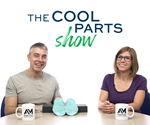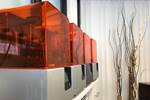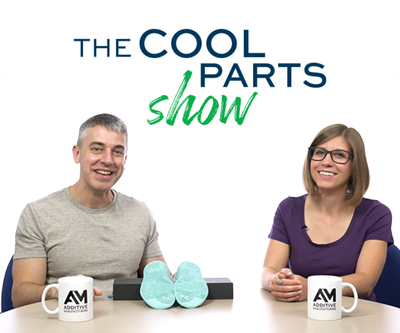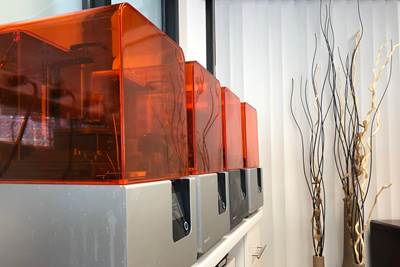How 3D Printing Changes Products in the Circular Economy (Video #4)
3D printing makes possible new and different consumer goods, but also changes the buyer's relationship to those goods. More in this video, part of our series on 3D Printing and the Circular Economy.
Conventionally manufactured products too often force the consumer to compromise. A pair of shoes may be slightly too small for the wearer’s feet; a table slightly too large for the space; the color of a lamp not quite the right match for the rest of the decor. Tooling holds these products back, forcing them into designated boxes and compelling the consumer to choose from options that often don’t quite work.
3D printing flips this scenario on its head; if complexity is free or nearly so, it is possible to make exactly the right shoe, table or lamp for the consumer’s needs and tastes. Learn how just the right product can support a more sustainable economy in this video, part of our series on 3D Printing and the Circular Economy.
Resources and Related Links
- Videos in this series: What Is the Circular Economy? | Materials | Design | Manufacturing | Product | End-of-Life
- Smartphone technology supports wearer-specific custom glasses
- Advanced scanner enables on demand, custom shoe insoles
- Sustainable furniture from custom design to end of life
Transcript
Welcome to our series on 3D printing and the circular economy. In this video, we'll take a look at how our relationship with products needs to change and the roles that 3D printing can play.
If you think about the products that you have around you right now, your shoes, your chair, maybe your jewelry, they come in these standardized sizes and configurations, but it's not because all human bodies fit into this set of sizes. It’s because someone has invested in time and money into making tooling that can produce these products in those standardized sizes. Once you have made that investment, it's a lot easier to just make a whole bunch of the same thing over and over again to change it up for every customer.
3D printing changes the game. Because there's no tooling you can not only produce on demand, you can actually design to order. There are companies doing this right now with smartphone scanning apps and parametric design tools in a browser that allow the customer to design exactly the pair of shoes, chair or ring that they want to wear.
The design freedoms possible with 3D printing allow products to more precisely fit a niche. If a customer can get exactly the pair of shoes that they want in the right size and shape for their foot, in the colors that they've chosen, that pair is going to last them a lot longer than an off-the-shelf pair of shoes that's not quite the to their tastes and doesn't quite fit right.
Finally, 3D printing enables easier recapture and repurposing of products at the end of their lifecycle. If you were paying attention in the Material and Design videos, you know that 3D printing allows us to use fewer materials and to use less material. It also enables us to add QR codes and other kinds of identifying information into products so that when that material is eventually recaptured, it's easier to process into something new.
With 3D printing, you can create exactly the product that your customer needs, put it out into the world and have a plan for what happens when it comes back. Learn more at gbm.media/circularAM and at AdditiveManufacturing.Media. Thank you for watching.
Related Content
Video: AM for Repair of Large Shafts
Wind power shafts that might once have been scrapped are now returned to service. See the robotic directed energy deposition (DED) and shaft preheating system developed by Ikergune, Izadi and Talens.
Read MoreVideo: A Mechanical Method for Metal Powder Production
Metal Powder Works has developed a method for producing powders from solid barstock, no melting required. This video covers how the process works and benefits of mechanical production of powders.
Read MoreSustainable Furniture Company Model No. Maintains Product Focus with Switch from DIY to Industrial 3D Printers
The startup founded in 2018 has matured in its product offerings as well as its manufacturing equipment, moving from homegrown 3D printers to industrial large-format machines.
Read MoreBMW Expands Use of Additive Manufacturing to Foster Production Innovations
The BMW Group is manufacturing many work aids and tools for its own production system using various 3D printing processes, with items such as tailor-made orthoses for employees, teaching and production aids, and large, weight-optimized robot grippers, which are used for such things as carbon fiber-reinforced polymer roofs and entire floor assemblies.
Read MoreRead Next
Shoe Insoles Precisely Tailored to Individual Feet: The Cool Parts Show #4
This episode of The Cool Parts Show looks at how 3D printing will deliver tailored products. Scanning feet for their geometry and pressure enables Aetrex and EOS to manufacture insoles that are unique to individual wearers.
Read MoreMore Sustainable Manufacturing Through 3D Printing (Video #3)
3D printing can support the circular economy by offering an alternative to centralized mass production. More in this video, part of our series on 3D Printing and the Circular Economy.
Read MoreBike Manufacturer Uses Additive Manufacturing to Create Lighter, More Complex, Customized Parts
Titanium bike frame manufacturer Hanglun Technology mixes precision casting with 3D printing to create bikes that offer increased speed and reduced turbulence during long-distance rides, offering a smoother, faster and more efficient cycling experience.
Read More
.jpg;width=70;height=70;mode=crop)



















